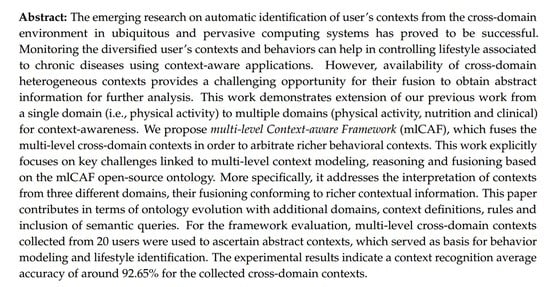mlCAF: Multi-Level Cross-Domain Semantic Context Fusioning for Behavior Identification
Abstract
:1. Introduction
2. Related Work
3. Preliminaries on the Mining Minds Platform
3.1. Role of Physical Activities and Nutrition in Diabetes Management
3.2. Mining Minds Context Ontology Evolution
3.3. High-Level Context Awareness in a Nutshell
4. Context Reasoning
4.1. Ontology Based Reasoning
4.2. SWRL Based Reasoning/SQWRL Based Retrieval
5. Multi-Level Cross-Domain Context Fusioning
5.1. Vertical Fusioning: Context Inferring in the Mining Minds
5.2. Horizontal Fusioning: Context Inferencing in the Mining Minds
6. Implementation Details
6.1. Test Environment
6.2. Semantic Web APIs Usage Details
6.3. Experimental Results
- Precision: Number of HLC correctly inferred by mlCAF divided by the total number of HLC defined in MMCO.
- Recall: Number of HLC correctly answered by the mlCAF divided by the total number of mlCAF in the dataset.
6.4. SQWRL based advanced Queries
- (i)
- If the user “u” has location “Loc_Gym”.
- (ii)
- The user “u” has PA-HLC as “Exercising” and it has some start time and end time.
- (iii)
- The duration is less than two hours.
- (iv)
- The difference in a number of days is less than seven days i.e., in a week.
- (v)
- User “u” has “Sedentary Behavior” if “Exercising” PA-HLC is less than two hours in a week.
- (i)
- If the user “u” has a low intensity activity such as walking “Act_Walking” which is subClassOf of PA-HLC.
- (ii)
- The user “u” has PA-HLC as “Exercising” with start-time and end-time.
- (iii)
- If the duration is between one hour and three hours.
- (iv)
- If the difference in the number of days is less than seven days i.e., in a week.
- (v)
- This SQWRL query selects the users “u” a “Lightly Active” if “Exercising” PA-HLC is between one hour and three hours but with LLC Activity as Act_Walking in a week.
- (i)
- If the user “u” has a moderately intensive activity such as Running with instance “Act_Running”, which is subClassOf of PA-HLC.
- (ii)
- The user “u” has PA-HLC as “Exercising” with start-time and end-time.
- (iii)
- If the duration is between three hour and five hours.
- (iv)
- If the difference in the number of days is less than seven days i.e., in a week.
- (v)
- This SQWRL query selects the users “u” a “Moderately Active” if “Exercising” PA-HLC is between three hours and five hours but with LLC Activity as Act_Running in a week.
- (i)
- If the user “u” has high intensive “Exercising” with start-time and end-time as PA-HLC.
- (ii)
- The duration of “Exercising” is between one hour and three hours.
- (iii)
- The intensive “Exercising” is being performed daily.
- (iv)
- This designed SQWRL query will retrieve a list of all users who perform high intensive “Exercising” and they are termed as having Very Active behavioral context as they are regularly engaged in performing physical activities.
- (i)
- If the user “u” has vigorous-intensive “Exercising” with start-time and end-time as PA-HLC.
- (ii)
- The duration of “Exercising” is between one hour and three hours.
- (iii)
- The vigorous-intensive “Exercising” is being performed twice a day.
- (iv)
- This SQWRL query will retrieve a list of all users who perform vigorous-intensive “Exercising” and the resultant users are considered to be of Extremely Active behavior, who perform intensive workouts twice a day having an overall duration of two hours or more.
- (i)
- If the user “u” has some activity “Eating”.
- (ii)
- The user “u” has N-HLC as “Eating” and it has some start time and end time.
- (iii)
- Count the activity “Eating” per day.
- (iv)
- The presented SQWRL query calculates the frequency of an activity “Eating” in a day for the users and returns all users with given conjunctive conditions.
7. Conclusions and Future Work
Acknowledgments
Author Contributions
Conflicts of Interest
Abbreviations
| MMCO | Mining Minds Context Ontology |
| LLC | Low-level Context |
| HLC | High-level Context |
| PA-HLC | Physical Activity High-level Context |
| N-HLC | Nutrition High-level Context |
| C-HLC | Clinical High-level Context |
| BP | Blood Pressure |
| BG | Blood Glucose |
| VF | Vertical Fusioning |
| HF | Horizontal Fusioning |
References
- Borges, V.; Jeberson, W. Survey of context information fusion for sensor networks based ubiquitous systems. arXiv, 2013; arXiv:1309.0598. [Google Scholar]
- Meditskos, G.; Dasiopoulou, S.; Kompatsiaris, I. MetaQ: A knowledge-driven framework for context-aware activity recognition combining SPARQL and OWL 2 activity patterns. Pervasive Mob. Comput. 2016, 25, 104–124. [Google Scholar] [CrossRef]
- Ni, Q.; Pau de la Cruz, I.; García Hernando, A.B. A foundational ontology-based model for human activity representation in smart homes. J. Ambient Intell. Smart Environ. 2016, 8, 47–61. [Google Scholar] [CrossRef]
- Abowd, G.D.; Dey, A.K.; Brown, P.J.; Davies, N.; Smith, M.; Steggles, P. Towards a better understanding of context and context-awareness. In Proceedings of the 1st International Symposium on Handheld and Ubiquitous Computing (HUC ’99), Karlsruhe, Germany, 27–29 September 1999; Springer: Berlin, Germany, 1999; pp. 304–307. [Google Scholar]
- Perera, C.; Zaslavsky, A.; Christen, P.; Georgakopoulos, D. Context aware computing for the internet of things: A survey. IEEE Commun. Surv. Tutor. 2014, 16, 414–454. [Google Scholar] [CrossRef]
- Villalonga, C.; Razzaq, M.A.; Khan, W.A.; Pomares, H.; Rojas, I.; Lee, S.; Banos, O. Ontology-Based High-Level Context Inference for Human Behavior Identification. Sensors 2016, 16, 1617. [Google Scholar] [CrossRef] [PubMed]
- Bae, I.H. An ontology-based approach to ADL recognition in smart homes. Future Gener. Comput. Syst. 2014, 33, 32–41. [Google Scholar] [CrossRef]
- Khattak, A.M.; Akbar, N.; Aazam, M.; Ali, T.; Khan, A.M.; Jeon, S.; Hwang, M.; Lee, S. Context representation and fusion: Advancements and opportunities. Sensors 2014, 14, 9628–9668. [Google Scholar] [CrossRef] [PubMed]
- Llinas, J.; Snidaro, L.; García, J.; Blasch, E. Context and fusion: Definitions, terminology. In Context-Enhanced Information Fusion; Springer: Cham, Switzerland, 2016; pp. 3–23. [Google Scholar]
- Alti, A.; Lakehal, A.; Laborie, S.; Roose, P. Autonomic Semantic-Based Context-Aware Platform for Mobile Applications in Pervasive Environments. Future Internet 2016, 8, 48. [Google Scholar] [CrossRef]
- Wang, M.; Perera, C.; Jayaraman, P.P.; Zhang, M.; Strazdins, P.; Ranjan, R. City Data Fusion: Sensor Data Fusion in the Internet of Things. arXiv, 2015; arXiv:1506.09118. [Google Scholar]
- Ni, Q.; García Hernando, A.B.; Pau de la Cruz, I. A Context-Aware System Infrastructure for Monitoring Activities of Daily Living in Smart Home. J. Sens. 2016, 2016, 9493047. [Google Scholar] [CrossRef]
- Villalonga, C.; Banos, O.; Khan, W.A.; Ali, T.; Razzaq, M.A.; Lee, S.; Pomares, H.; Rojas, I. High-Level Context Inference for Human Behavior Identification. In Ambient Assisted Living. ICT-Based Solutions in Real Life Situations; Springer: Cham, Switzerland, 2015; pp. 164–175. [Google Scholar]
- HLCA at Github. Available online: https://github.com/ubiquitous-computing-lab/Mining-Minds/tree/master/information-curation-layer/high-level-context-awareness (accessed on 20 September 2017).
- Colberg, S.R.; Sigal, R.J.; Yardley, J.E.; Riddell, M.C.; Dunstan, D.W.; Dempsey, P.C.; Horton, E.S.; Castorino, K.; Tate, D.F. Physical activity/exercise and diabetes: A position statement of the American Diabetes Association. Diabetes Care 2016, 39, 2065–2079. [Google Scholar] [CrossRef] [PubMed]
- World Health Organization. Global Report on Diabetes; World Health Organization: Geneva, Switzerland, 2016. [Google Scholar]
- Yúrúr, Ó.; Liu, C.H.; Sheng, Z.; Leung, V.C.; Moreno, W.; Leung, K.K. Context-awareness for mobile sensing: A survey and future directions. IEEE Commun. Surv. Tutor. 2016, 18, 68–93. [Google Scholar] [CrossRef]
- Baldauf, M.; Dustdar, S.; Rosenberg, F. A survey on context-aware systems. Int. J. Ad Hoc Ubiquitous Comput. 2007, 2, 263–277. [Google Scholar] [CrossRef]
- Ponce, V.; Roy, P.; Abdulrazak, B. Dynamic Domain Model for Micro Context-Aware Adaptation of Applications. In Proceedings of the 2016 IEEE Intl IEEE Conferences Ubiquitous Intelligence & Computing, Advanced and Trusted Computing, Scalable Computing and Communications, Cloud and Big Data Computing, Internet of People, and Smart World Congress (UIC/ATC/ScalCom/CBDCom/IoP/SmartWorld), Toulouse, France, 18–21 July 2016; pp. 98–105. [Google Scholar]
- Zheng, Y.; Pan, W.; Sahebi, S.S.; Fernández, I. The 1st Workshop on Intelligent Recommender Systems by Knowledge Transfer & Learning (RecSysKTL). In Proceedings of the Eleventh ACM Conference on Recommender Systems, Como, Italy, 27–31 August 2017; ACM: New York, NY, USA, 2017; pp. 366–367. [Google Scholar]
- Guo, B.; Sun, L.; Zhang, D. The architecture design of a cross-domain context management system. In Proceedings of the 2010 8th IEEE International Conference on Pervasive Computing and Communications Workshops (PERCOM Workshops), Mannheim, Germany, 29 March–2 April 2010; pp. 499–504. [Google Scholar]
- Guo, B.; Zhang, D.; Sun, L.; Yu, Z.; Zhou, X. iCROSS: Toward a scalable infrastructure for cross-domain context management. Pers. Ubiquitous Comput. 2013, 17, 591–602. [Google Scholar] [CrossRef]
- Lin, D.; Kapoor, A.; Hua, G.; Baker, S. Joint people, event, and location recognition in personal photo collections using cross-domain context. In Proceedings of the European Conference on Computer Vision–ECCV 2010, Crete, Greece, 5–11 September 2010; pp. 243–256. [Google Scholar]
- Snidaro, L.; García, J.; Llinas, J. Context-based information fusion: A survey and discussion. Inf. Fusion 2015, 25, 16–31. [Google Scholar] [CrossRef]
- Tria, S.B.; Seridi-Bouchelaghem, H.; Mokhati, F. An Ontology-Based Context Model to Manage Users Preferences And Conflicts. Informatica 2016, 40, 71. [Google Scholar]
- Gu, T.; Pung, H.K.; Zhang, D.Q. A service-oriented middleware for building context-aware services. J. Netw. Comput. Appl. 2005, 28, 1–18. [Google Scholar] [CrossRef]
- Chen, H.; Finin, T.; Joshi, A.; Kagal, L.; Perich, F.; Chakraborty, D. Intelligent agents meet the semantic web in smart spaces. IEEE Internet Comput. 2004, 8, 69–79. [Google Scholar] [CrossRef]
- Riboni, D.; Bettini, C. COSAR: hybrid reasoning for context-aware activity recognition. Pers. Ubiquitous Comput. 2011, 15, 271–289. [Google Scholar] [CrossRef]
- Chi, Y.L.; Chen, T.Y.; Tsai, W.T. A chronic disease dietary consultation system using OWL-based ontologies and semantic rules. J. Biomed. Inform. 2015, 53, 208–219. [Google Scholar] [CrossRef] [PubMed]
- Okeyo, G.; Chen, L.; Wang, H. Combining ontological and temporal formalisms for composite activity modelling and recognition in smart homes. Future Gener. Comput. Syst. 2014, 39, 29–43. [Google Scholar] [CrossRef]
- Smirnov, A.; Levashova, T.; Shilov, N. Patterns for context-based knowledge fusion in decision support systems. Inf. Fusion 2015, 21, 114–129. [Google Scholar] [CrossRef]
- Wang, P.; Luo, H.; Sun, Y. A Habit-based SWRL Generation and Reasoning Approach in Smart Home. In Proceedings of the 2015 IEEE 21st International Conference on Parallel and Distributed Systems (ICPADS), Melbourne, Australia, 14–17 December 2015; pp. 770–775. [Google Scholar]
- Banos, O.; Amin, M.B.; Khan, W.A.; Afzal, M.; Hussain, M.; Kang, B.H.; Lee, S. The Mining Minds digital health and wellness framework. Biomed. Eng. OnLine 2016, 15, 76. [Google Scholar] [CrossRef] [PubMed]
- Banos, O.; Bang, J.H.; Hur, T.H.; Siddiqui, M.; Huynh-The, T.; Vui, L.B.; Ali-Khan, W.; Ali, T.; Villalonga, C.; Lee, S. Mining Human Behavior for Health Promotion. In Proceedings of the 37th Annual International Conference of the IEEE Engineering in Medicine and Biology Society (EMBC 2015), Milan, Italy, 25–29 August 2015. [Google Scholar]
- Banos, O.; Villalonga, C.; Bang, J.H.; Hur, T.H.; Kang, D.; Park., S.B.; Hyunh-The, T.; Vui, L.B.; Amin, M.B.; Razzaq, M.A.; et al. Human Behavior Analysis by means of Multimodal Context Mining. Sensors 2016, 16, 1264. [Google Scholar] [CrossRef] [PubMed]
- Færch, K.; Witte, D.R.; Brunner, E.; Kivimäki, M.; Tabak, A.; Jørgensen, M.E.; Ekelund, U.; Vistisen, D. Physical Activity and Improvement of Glycaemia in Pre-diabetes by Different Diagnostic Criteria. J. Clin. Endocrinol. Metab. 2017, 102, 3712–3721. [Google Scholar] [CrossRef] [PubMed]
- Han, Y.; Han, M.; Lee, S.; Sarkar, A.; Lee, Y.K. A framework for supervising lifestyle diseases using long-term activity monitoring. Sensors 2012, 12, 5363–5379. [Google Scholar] [CrossRef] [PubMed]
- Mining Minds Context Ontology. Available online: http://www.miningminds.re.kr/lifelog/context/context-v3.0.owl (accessed on 20 September 2017).
- American-Diabetes-Association. Available online: http://diabetes.org/ (accessed on 20 September 2017).
- Giles, T.D.; Berk, B.C.; Black, H.R.; Cohn, J.N.; Kostis, J.B.; Izzo, J.L.; Weber, M.A. Expanding the definition and classification of hypertension. J. Clin. Hypertens. 2005, 7, 505–512. [Google Scholar] [CrossRef]
- Skillen, K.L.; Chen, L.; Burns, W. VIPR: A Visual Interface Tool for Programming Semantic Web Rules. In Proceedings of the 2016 Intl IEEE Conferences Ubiquitous Intelligence & Computing, Advanced and Trusted Computing, Scalable Computing and Communications, Cloud and Big Data Computing, Internet of People, and Smart World Congress (UIC/ATC/ScalCom/CBDCom/IoP/SmartWorld), Toulouse, France, 18–21 July 2016; pp. 277–284. [Google Scholar]
- O’Connor, M.; Das, A. SQWRL: A query language for OWL. In Proceedings of the 6th International Conference on OWL: Experiences and Directions, Chantilly, VA, USA, 23–24 October 2009; Volume 529, pp. 208–215. [Google Scholar]
- Brickley, D.; Guha, R.V. RDF Schema 1.1. W3C Recommendation. 25 February 2014. Available online: https://www.w3.org/TR/rdf-schema/ (accessed on 20 September 2017).
- W3C OWL Working Group. OWL 2 Web Ontology Language: Document Overview, 2nd ed. W3C Recommendation. 11 December 2012. Available online: http://www.w3.org/TR/owl2-overview/ (accessed on 20 September 2017).
- Harris, S.; Seaborne, A. SPARQL 1.1 (SPARQL Query Language for RDF). W3C Recommendation. 21 March 2013. Available online: http://www.w3.org/TR/sparql11-query/ (accessed on 20 September 2017).
- Mattson, M.P.; Allison, D.B.; Fontana, L.; Harvie, M.; Longo, V.D.; Malaisse, W.J.; Mosley, M.; Notterpek, L.; Ravussin, E.; Scheer, F.A.; et al. Meal frequency and timing in health and disease. Proc. Natl. Acad. Sci. USA 2014, 111, 16647–16653. [Google Scholar] [CrossRef] [PubMed]


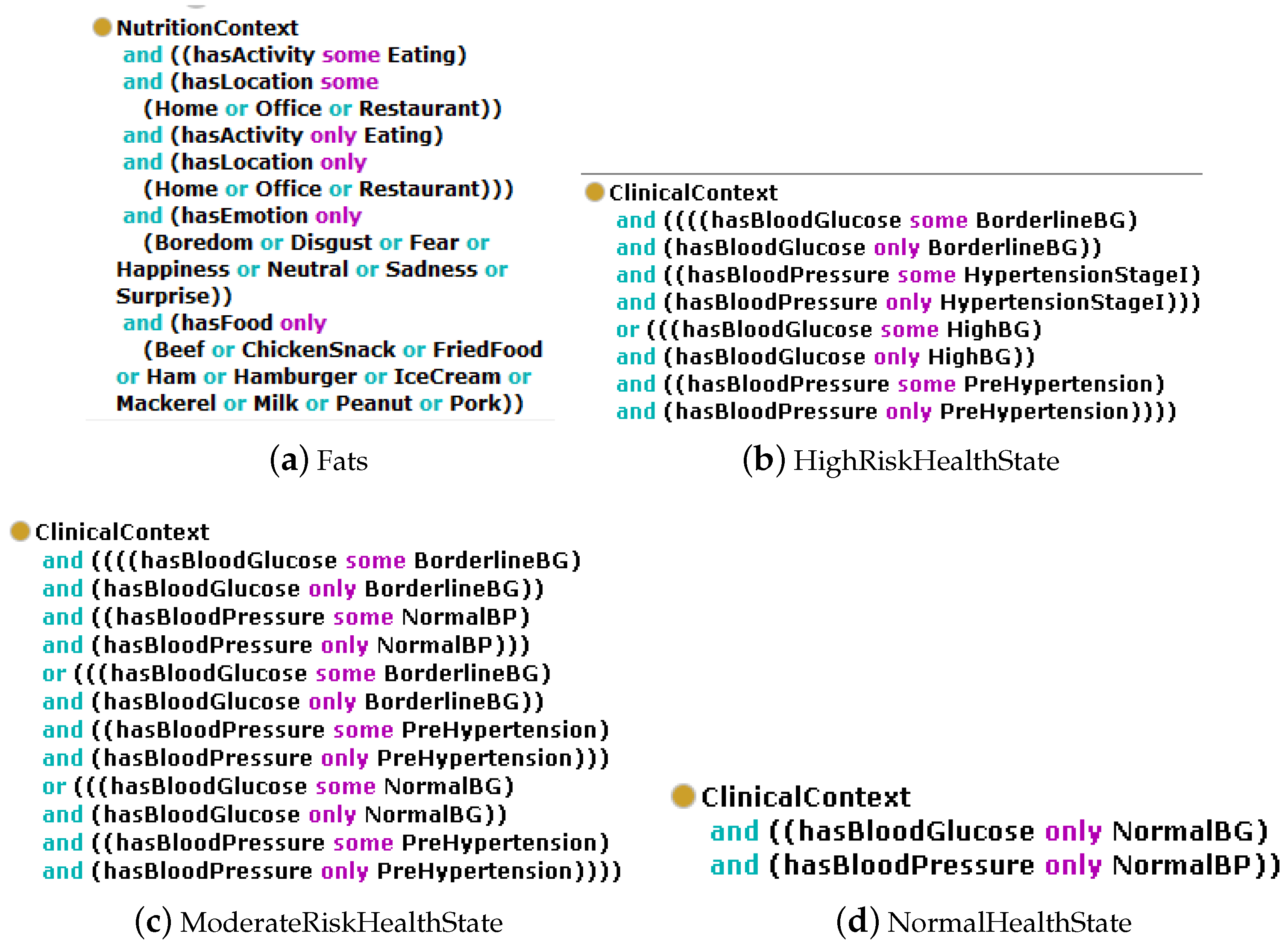

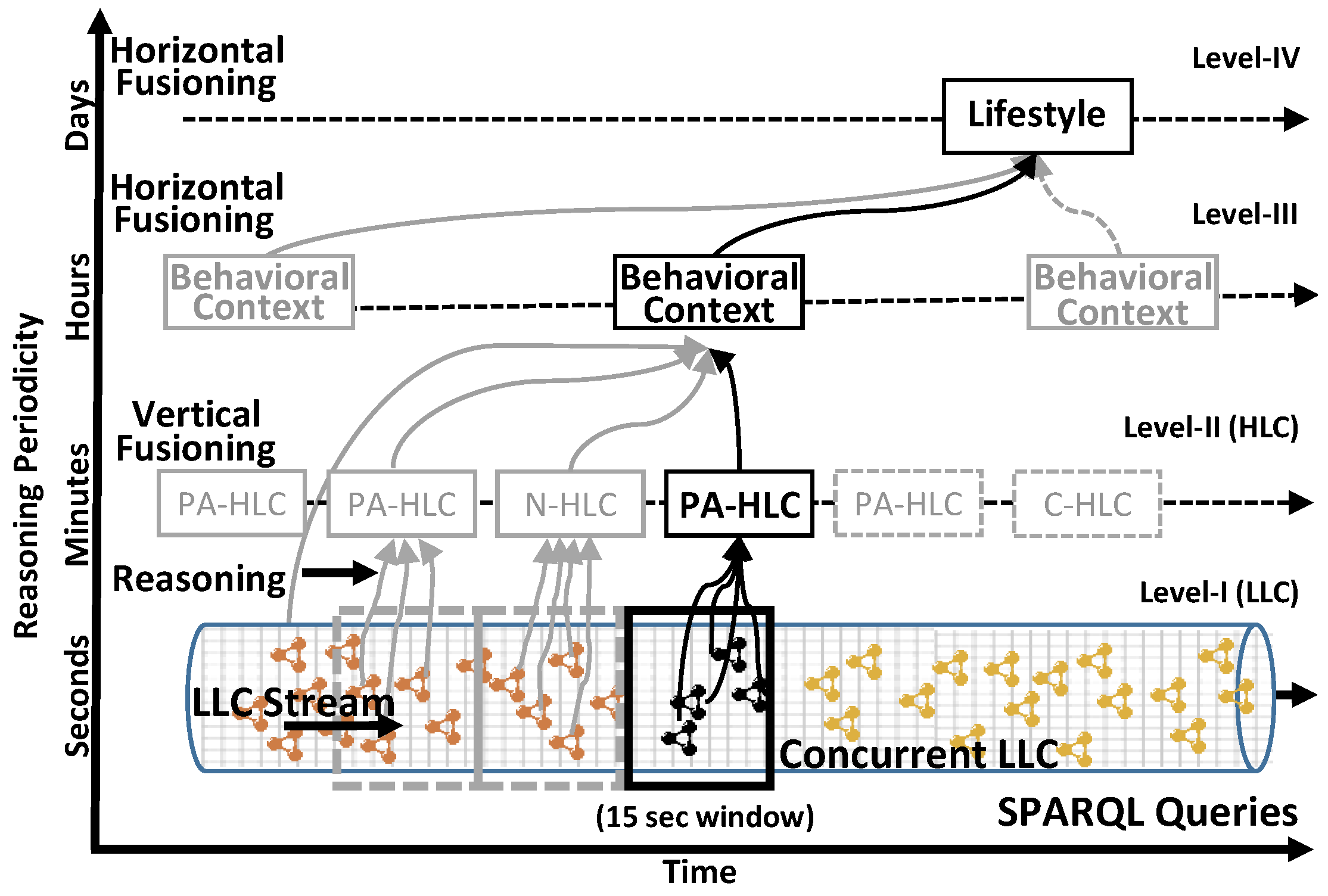


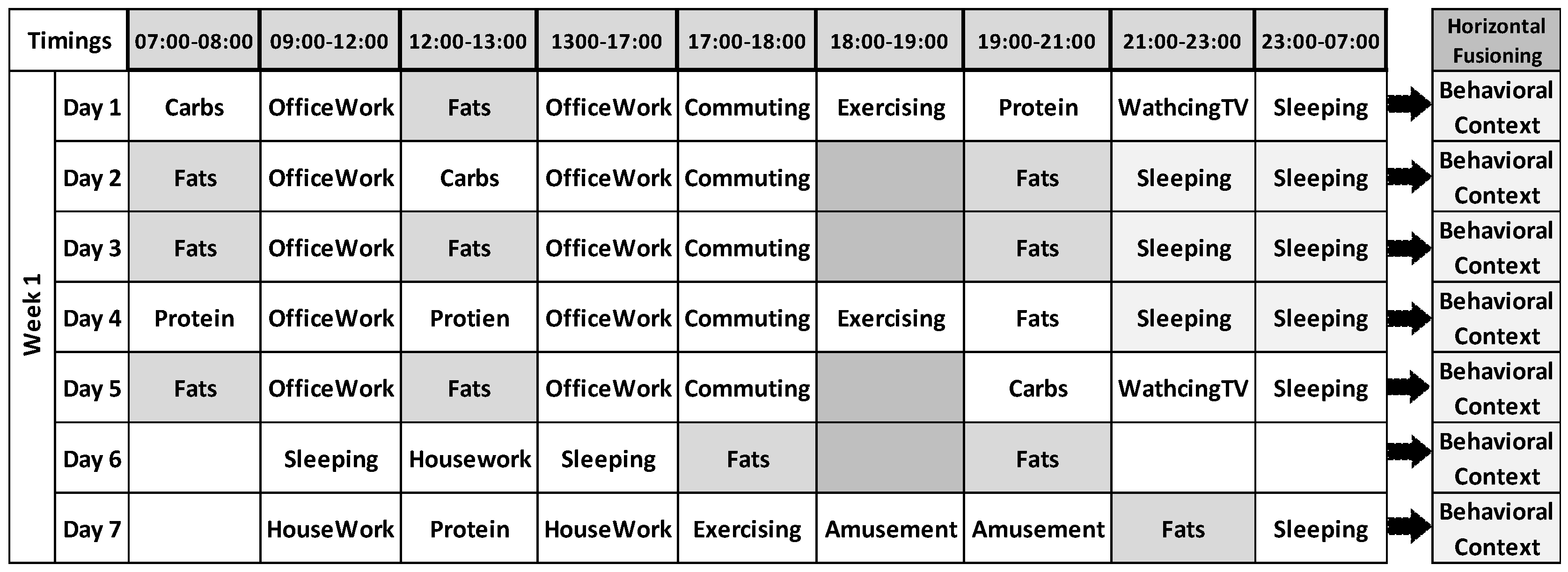
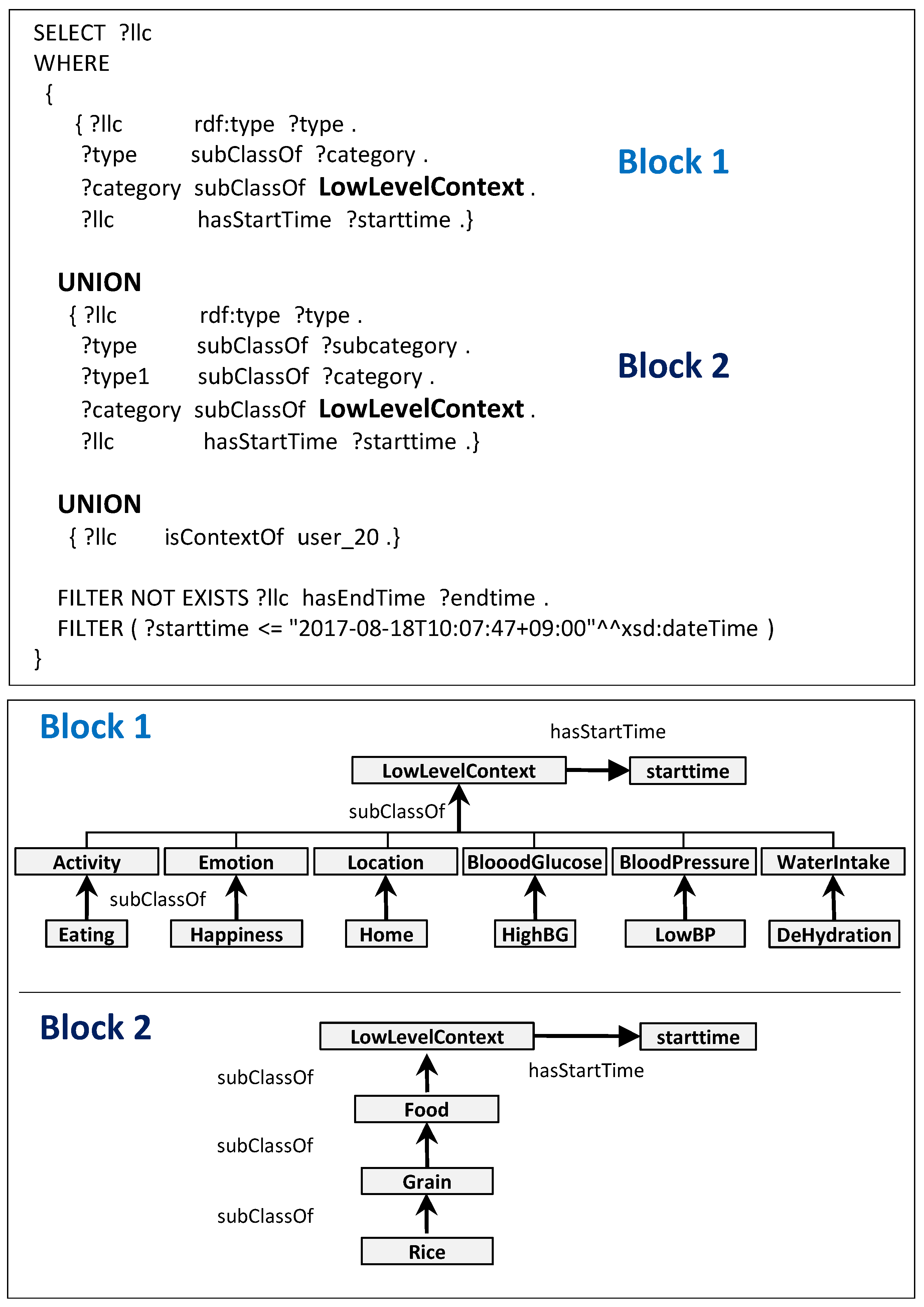
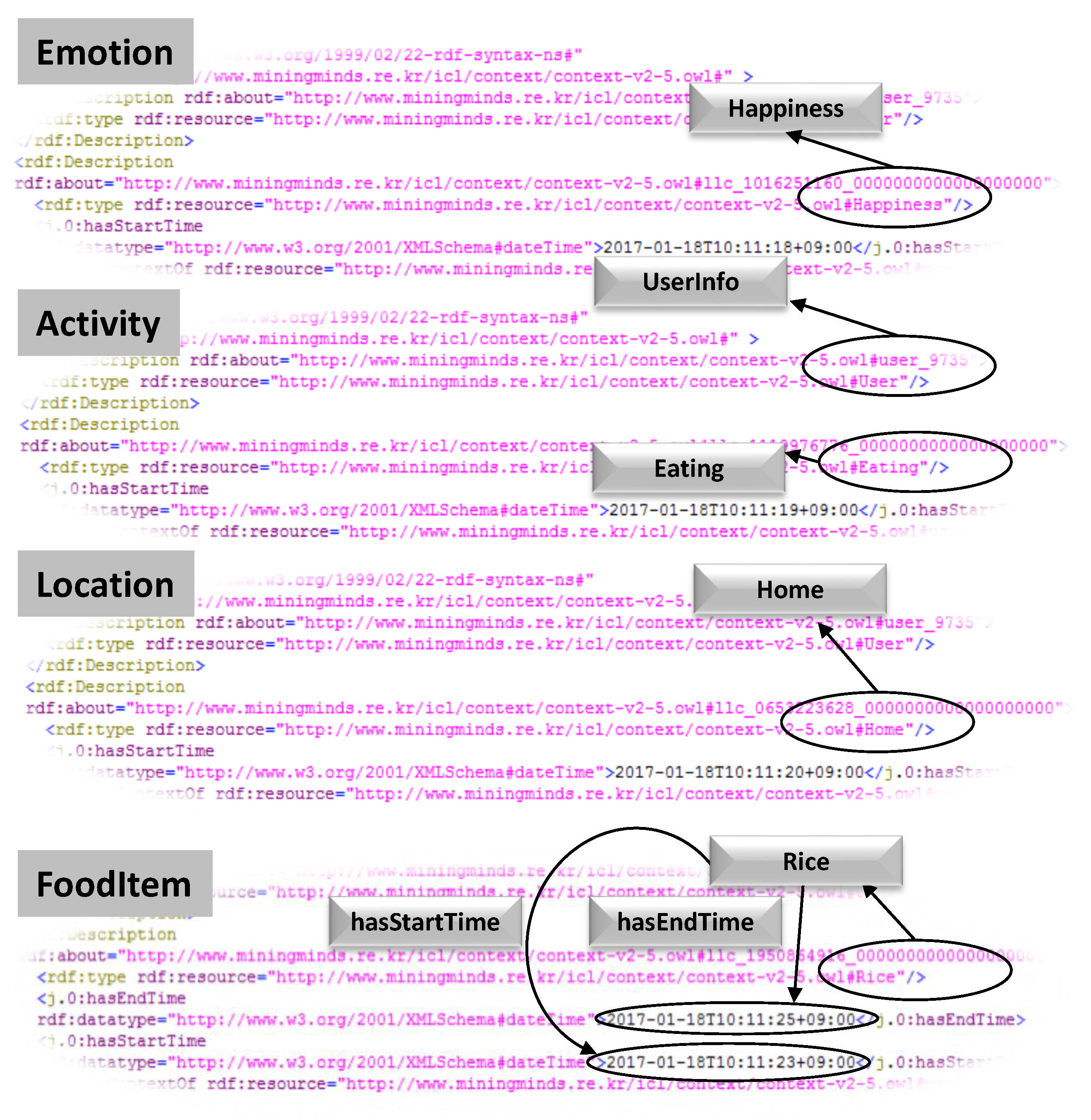

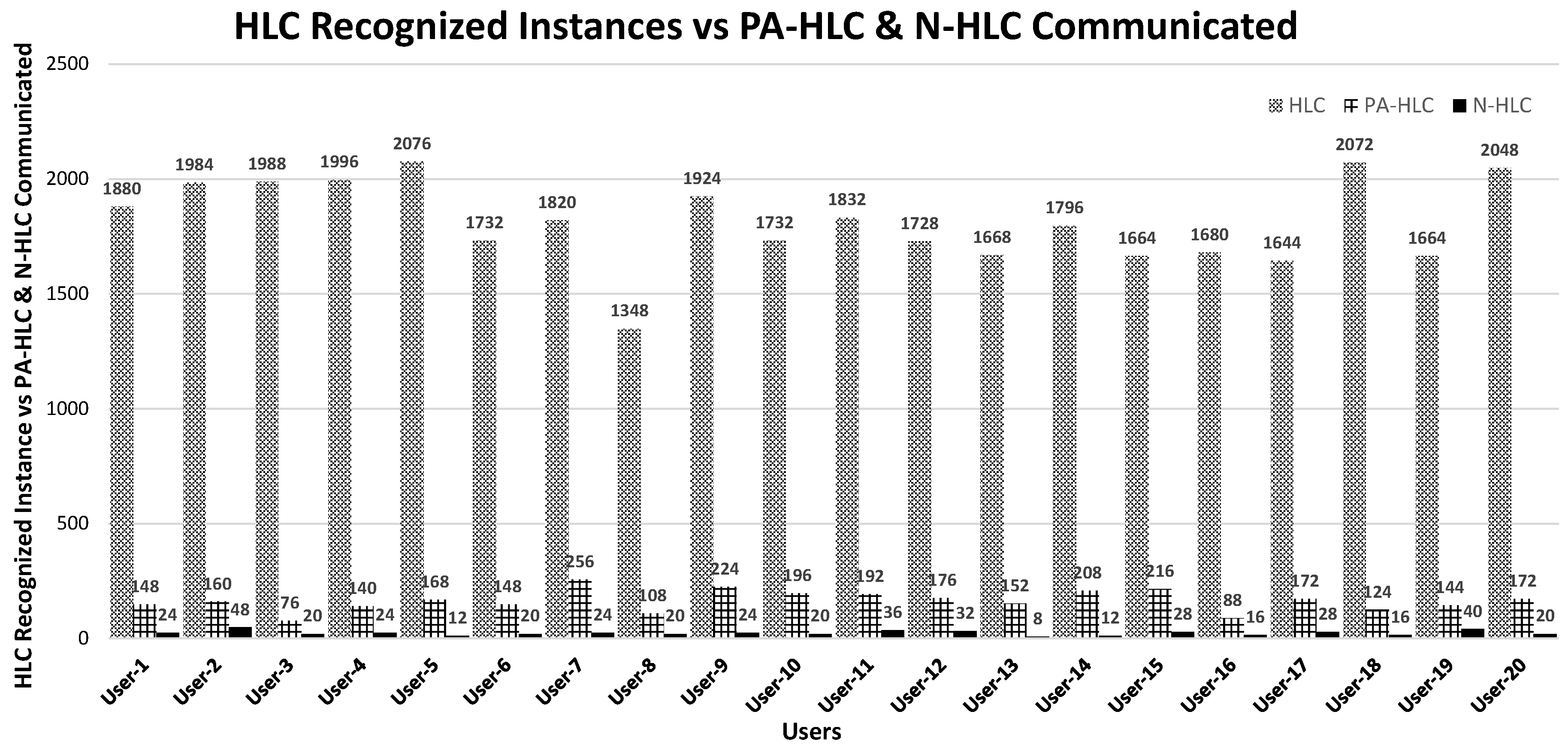

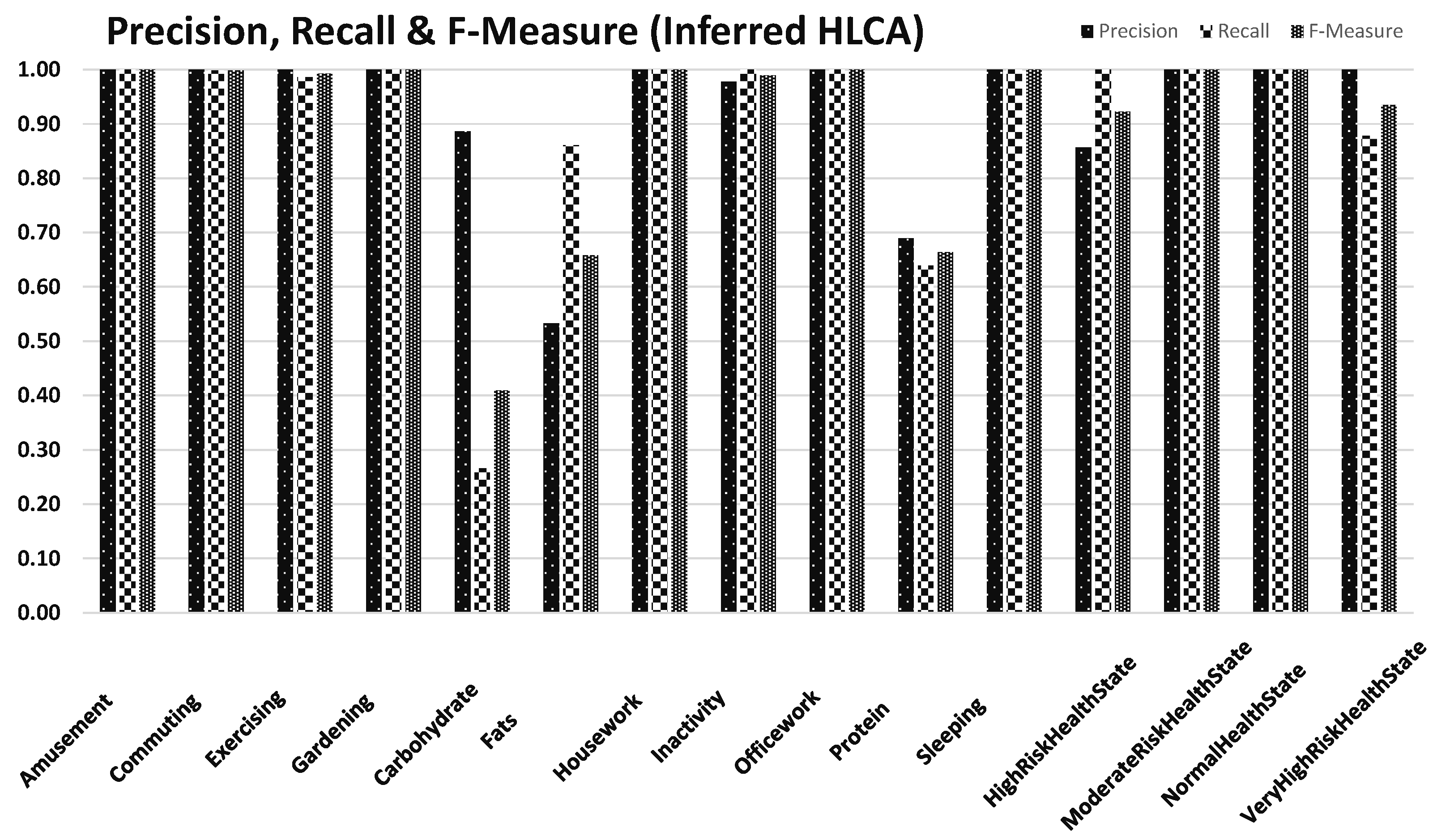


| MMCO Metrics | Metrics Detail | MMCO V2.0 (Existing Work) [6] | MMCO V3.0 (Extended Work) |
|---|---|---|---|
| Metrics | Axioms | 793 | 1092 |
| Logical Axioms | 624 | 859 | |
| Class count | 45 | 225 | |
| Object Property count | 3 | 25 | |
| Individual count | 114 | 157 | |
| DL Expressivity | ALCO | ALCHOF(D) | |
| Asserted Triples | 0 | 3312 | |
| Inferred Triples | 0 | 6041 | |
| Class Axioms | SubClassOf | 32 | 222 |
| Equivalent Classes | 9 | 17 | |
| Disjoint Classes | 5 | 14 | |
| Individual Axioms | Class Assertion | 360 | 58 |
| Object Property Assertion | 212 | 27 | |
| Data Property Assertion | 0 | 1 |
| Category | Low-Level Context Labels | Value Ranges |
|---|---|---|
| Blood Glucose [39] (mg/dL) | DangerouslyHighBG | ≥315 |
| HighBG | >215 & <280 | |
| BorderlineBG | >120 & <180 | |
| NormalBG | >70 & <108 | |
| LowBG | >50 & <70 | |
| DangerouslyLowBG | ≤50 | |
| Blood Pressure (Systolic/Diastolic) [40] | HypertensionStageII | ≥160/100 |
| HypertensionStageI | >140/90 & <159/99 | |
| PreHypertension | >120/80 & <139/89 | |
| NormalBP | ≤120/80 | |
| LowBP | <90/60 | |
| Water Intake (mL) | OverHydration | >2000 mL |
| NormalIntake | approx. 2000 mL | |
| Dehydration | <2000 mL |
| Rule | Behavioral Contexts | SWRL/SQWRL Horizontal Fusion Rules |
|---|---|---|
| 1 | Sedentary Behavior | User(?u) ∧ hasLocation(?u, Loc_Gym) ∧ isContextOf(?u, ?PAC-HLC) ∧ swrlb:equal(?PAC-HLC, “Exercising”) ∧ hasStartTime(?PAC-HLC, ?starttime) ∧ hasEndTime(?PAC-HLC, ?endtime) ∧ temporal:duration(?h, ?starttime, ?endtime, ”Hours”) ∧ temporal:duration(?d, ?starttime, ?endtime, “Days”) ∧ swrlb:lessThan (?h, 2) ∧ swrlb:lessThan(?d, 7) -> sqwrl:select(?u, ?h, ?d) |
| 2 | Lightly Active | User(?u) ∧ hasActivity(?u, Act_Walking) ∧ isContextOf(?u, ?PAC-HLC) ∧ swrlb:equal(?PAC-HLC, “Exercising”) ∧ hasStartTime(?PAC-HLC, ?starttime) ∧hasEndTime(?PAC-HLC, ?endtime) ∧ temporal:duration(?h, ?starttime, ?endtime, “Hours”) ∧ temporal:duration(?d, ?starttime, ?endtime, “Days”) ∧ swrlb:greaterThan(?h, 1) ∧ swrlb:lessThan(?h, 3) ∧ swrlb:equal(?d, 7) -> sqwrl:select(?u, ?h, ?d) |
| 3 | Moderately Active | User(?u) ∧ hasActivity(?u, Act_Running) ∧ isContextOf(?u, ?PAC-HLC) ∧ swrlb:equal(?PAC-HLC, “Exercising”) ∧ hasStartTime(?PAC-HLC, ?starttime) ∧ hasEndTime(?PAC-HLC, ?endtime) ∧ temporal:duration(?h, ?starttime, ?endtime, “Hours”) ∧ temporal:duration(?d, ?starttime, ?endtime, “Days”) ∧ swrlb:greaterThan(?h, 3) ∧ swrlb:lessThan(?h, 5) ∧ swrlb:equal(?d, 7) -> sqwrl:select(?u, ?h, ?d) |
| 4 | Very Active | User(?u) ∧ isContextOf(?u, ?PAC-HLC) ∧ swrlb:equal(?PAC-HLC, “Exercising”) ∧ hasStartTime(?PAC-HLC, ?starttime) ∧ hasEndTime(?PAC-HLC, ?endtime) ∧ temporal:duration(?h, ?starttime, ?endtime, “Hours”) ∧ temporal:duration(?d, ?starttime, ?endtime, “Days”) ∧ swrlb:greaterThan(?h, 1) ∧ swrlb:lessThan(?h, 3) ∧ sqwrl:makeSet(?s, ?d) ∧ sqwrl:groupBy(?s, ?d) ∧ sqwrl:size(?no_of_days, ?s) ∧ swrlb:equal(?no_of_days, 7) -> sqwrl:select(?u, ?h, ?no_of_days) |
| 5 | Extremely Active | User(?u) ∧ isContextOf(?u, ?PAC-HLC) ∧ swrlb:equal(?PAC-HLC, “Exercising”) ∧ hasStartTime(?PAC-HLC, ?starttime) ∧ hasEndTime(?PAC-HLC, ?endtime) ∧ temporal:duration(?h, ?starttime, ?endtime, “Hours”) ∧ temporal:duration(?d, ?starttime, ?endtime, “Days”) ∧ swrlb:greaterThan(?h, 1) ∧ swrlb:lessThan(?h, 3) ∧ sqwrl:makeSet (?s, ?PA-HLC) ∧ sqwrl:groupBy(?s, ?PA-HLC) ∧ sqwrl:size(?Exercise_per_day, ?s) ∧ swrlb:equal(?Exercise_per_day, 2) -> sqwrl:select(?u, ?h, ?Exercise_per_day) |
| 6 | Meal Frequency | User(?u)∧ hasActivity(?u, ?Act) ∧ swrlb:equal(?Act, ”Eating”) ∧ hasStartTime(?Act, ?starttime) ∧ hasEndTime(?Act, ?endtime) ∧ temporal:duration(?d, ?starttime, ?endtime, “Days”) ∧ sqwrl:makeSet(?s, ?d) ∧ sqwrl:groupBy(?s, ?d) ∧ sqwrl:size(?no_of_days, ?s) ∧ swrlb:equal(?no_of_days, 1) ∧ sqwrl:makeSet(?Actset, ?Act) ∧ sqwrl:groupBy(?Actset, ?p) ∧ sqwrl:size(?freq, ?Actset) ∧ swrlb:greaterThan(?freq, 2) -> sqwrl:select(?u, ?freq,?no_of_days) |
© 2017 by the authors. Licensee MDPI, Basel, Switzerland. This article is an open access article distributed under the terms and conditions of the Creative Commons Attribution (CC BY) license (http://creativecommons.org/licenses/by/4.0/).
Share and Cite
Razzaq, M.A.; Villalonga, C.; Lee, S.; Akhtar, U.; Ali, M.; Kim, E.-S.; Khattak, A.M.; Seung, H.; Hur, T.; Bang, J.; et al. mlCAF: Multi-Level Cross-Domain Semantic Context Fusioning for Behavior Identification. Sensors 2017, 17, 2433. https://doi.org/10.3390/s17102433
Razzaq MA, Villalonga C, Lee S, Akhtar U, Ali M, Kim E-S, Khattak AM, Seung H, Hur T, Bang J, et al. mlCAF: Multi-Level Cross-Domain Semantic Context Fusioning for Behavior Identification. Sensors. 2017; 17(10):2433. https://doi.org/10.3390/s17102433
Chicago/Turabian StyleRazzaq, Muhammad Asif, Claudia Villalonga, Sungyoung Lee, Usman Akhtar, Maqbool Ali, Eun-Soo Kim, Asad Masood Khattak, Hyonwoo Seung, Taeho Hur, Jaehun Bang, and et al. 2017. "mlCAF: Multi-Level Cross-Domain Semantic Context Fusioning for Behavior Identification" Sensors 17, no. 10: 2433. https://doi.org/10.3390/s17102433




